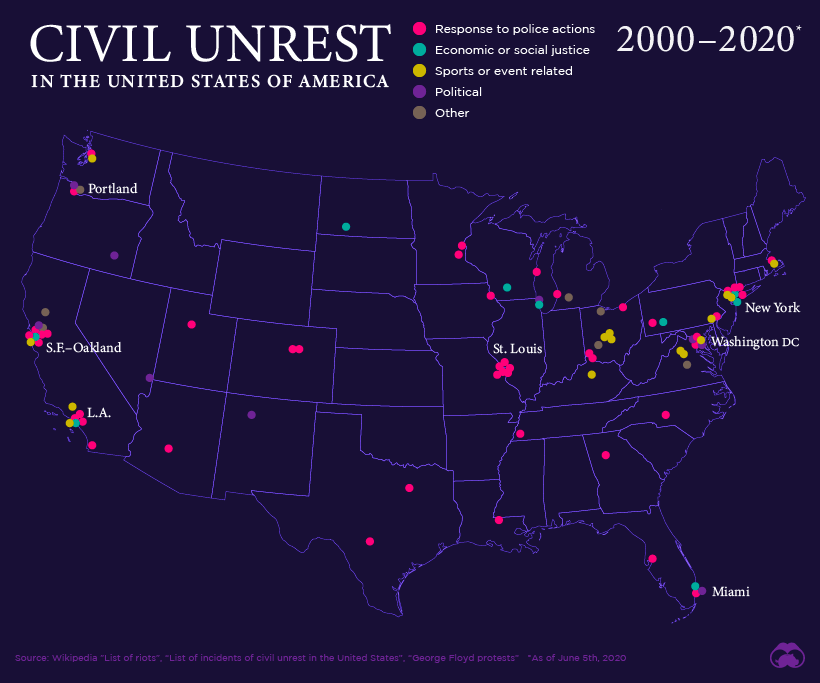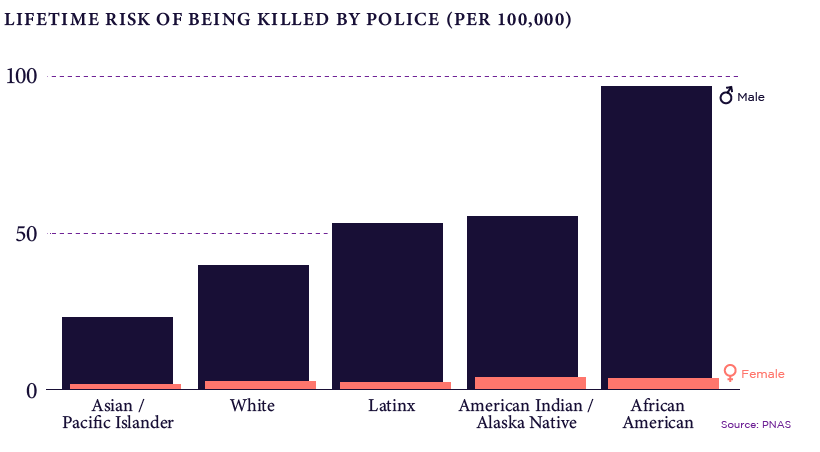Protests are a regular feature of democratic society, but they can occasionally cross over from non-violent demonstrations into civil unrest. Even protests that are largely peaceful can still result in arrests, violence, police aggression, and property damage. Our animated map above looks at the last two decades of civil unrest in the United States using lists compiled on Wikipedia. Instances of civil unrest eventually leave the news cycle, and we rarely have the chance to examine the bigger picture or see where they fit within a nation-wide pattern.
From this map we can see that certain cities, such as St. Louis and Oakland, have been disproportionately impacted by civil unrest. As well, universities have also been hotspots for rioting, though often for much different reasons. Looking back over two decades, we see that instances of civil unrest in the United States have fallen into roughly four categories: Let’s take a look at a prominent example in each of these categories, to get further context.
Examples of Civil Unrest, by Category
1. Economic and Social Justice
One of the most prominent examples in this category is the Occupy Wall Street movement. The protests began in September 2011 in Downtown Manhattan, and soon spread through cities throughout the world. In 2016, the Dakota Access Pipeline protests grabbed headlines around the world as protesters faced off against armed soldiers and police with riot gear and military equipment. By the time camps were broken up the next year, hundreds of people had been arrested.
2. Sports and Event Related Riots
Between 2000 and 2010, the majority of incidents plotted on the map are related to sports and events. This includes major sporting events like the L.A. Lakers championship win in 2000, but also the University of Maryland riot of 2004, where rowdy post-game celebrations crossed over into arson and property damage. A more recent example is the Philadelphia Eagles’ first-ever Super Bowl victory in 2018, where celebrations eventually got out of hand.
3. Politically Motivated Civil Unrest
The political divide has been growing in America for years now, but those differences more frequently resulted in confrontations and civil unrest in 2016. After the election of Donald Trump, for example, protests erupted in many cities, with riots breaking out in Portland, Oregon, and Oakland, California. Of course, the “Bundy standoff” – an armed confrontation between supporters of cattle rancher Cliven Bundy and law enforcement over withheld grazing fees – showed that not all civil unrest takes place in America’s cities.
4. Reaction to Police Actions
Some of the biggest flashpoints seen in recent years have been in response to people who were killed by police. In fact, more than half of the points on our map were a direct response to incidents in which a person – typically a black male – died at the hands of law enforcement officials. In previous years, the unrest that followed was typically confined to the cities where the death took place, but protests are now increasingly erupting in cities around the country.
The Situation Now
The death of George Floyd – the latest black male to be killed during an encounter with law enforcement – has had a ripple effect, spawning protests in cities around the United States and internationally. As our map showing the history of civil unrest makes clear, excessive force from police against black citizens is nothing new. The data shows that black men have by far the highest risk of being killed in an encounter with law enforcement.
Until these systemic issues are addressed, history may not be repeat exactly, but the rhyme will sound very, very familiar. on Even while political regimes across these countries have changed over time, they’ve largely followed a few different types of governance. Today, every country can ultimately be classified into just nine broad forms of government systems. This map by Truman Du uses information from Wikipedia to map the government systems that rule the world today.
Countries By Type of Government
It’s important to note that this map charts government systems according to each country’s legal framework. Many countries have constitutions stating their de jure or legally recognized system of government, but their de facto or realized form of governance may be quite different. Here is a list of the stated government system of UN member states and observers as of January 2023: Let’s take a closer look at some of these systems.
Monarchies
Brought back into the spotlight after the death of Queen Elizabeth II of England in September 2022, this form of government has a single ruler. They carry titles from king and queen to sultan or emperor, and their government systems can be further divided into three modern types: constitutional, semi-constitutional, and absolute. A constitutional monarchy sees the monarch act as head of state within the parameters of a constitution, giving them little to no real power. For example, King Charles III is the head of 15 Commonwealth nations including Canada and Australia. However, each has their own head of government. On the other hand, a semi-constitutional monarchy lets the monarch or ruling royal family retain substantial political powers, as is the case in Jordan and Morocco. However, their monarchs still rule the country according to a democratic constitution and in concert with other institutions. Finally, an absolute monarchy is most like the monarchies of old, where the ruler has full power over governance, with modern examples including Saudi Arabia and Vatican City.
Republics
Unlike monarchies, the people hold the power in a republic government system, directly electing representatives to form government. Again, there are multiple types of modern republic governments: presidential, semi-presidential, and parliamentary. The presidential republic could be considered a direct progression from monarchies. This system has a strong and independent chief executive with extensive powers when it comes to domestic affairs and foreign policy. An example of this is the United States, where the President is both the head of state and the head of government. In a semi-presidential republic, the president is the head of state and has some executive powers that are independent of the legislature. However, the prime minister (or chancellor or equivalent title) is the head of government, responsible to the legislature along with the cabinet. Russia is a classic example of this type of government. The last type of republic system is parliamentary. In this system, the president is a figurehead, while the head of government holds real power and is validated by and accountable to the parliament. This type of system can be seen in Germany, Italy, and India and is akin to constitutional monarchies. It’s also important to point out that some parliamentary republic systems operate slightly differently. For example in South Africa, the president is both the head of state and government, but is elected directly by the legislature. This leaves them (and their ministries) potentially subject to parliamentary confidence.
One-Party State
Many of the systems above involve multiple political parties vying to rule and govern their respective countries. In a one-party state, also called a single-party state or single-party system, only one political party has the right to form government. All other political parties are either outlawed or only allowed limited participation in elections. In this system, a country’s head of state and head of government can be executive or ceremonial but political power is constitutionally linked to a single political movement. China is the most well-known example of this government system, with the General Secretary of the Communist Party of China ruling as the de facto leader since 1989.
Provisional
The final form of government is a provisional government formed as an interim or transitional government. In this system, an emergency governmental body is created to manage political transitions after the collapse of a government, or when a new state is formed. Often these evolve into fully constitutionalized systems, but sometimes they hold power for longer than expected. Some examples of countries that are considered provisional include Libya, Burkina Faso, and Chad.





